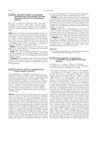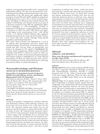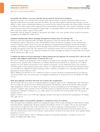
Search
for
Sort by
Research
300-330 / 1000+ results

research Stabilizing Mutations of KLHL24 Ubiquitin Ligase Cause Loss of Keratin 14 and Human Skin Fragility
Certain mutations in the KLHL24 gene cause a skin disorder by breaking down an important skin protein.

research Dietary Fat- and Obesity-Sensitive Dermal Adipocyte PKCβ Induction and Inflammation Cross-Talk
Eating a lot of fat increases PKCβ and inflammation in skin fat cells, which affects skin and hair health.

research The Role of Astrotactin2 in Regulating Mammalian Skin Polarity
Astrotactin2 affects hair follicle orientation and skin cell polarity.

research Development of an Intrinsic Skin Sensor for Blood Glucose Level with CRISPR-Mediated Genome Editing in Epidermal Stem Cells
Researchers created a skin graft that senses blood glucose and could treat diabetes using CRISPR-edited stem cells.

research A Homozygous Single T Deletion Found in the GGCX Gene with PXE-Like Phenotypes
A gene mutation worsens skin irritation in mice due to a lack of certain fats.

research Case of Epidermolytic Ichthyosis with a Novel L157P Mutation in KRT10 Complicated by Hypercalcemia
A man with a rare skin condition and a new gene mutation developed high calcium levels due to his treatment.

research Transnosography of Impulsiveness: A Comparison Among Different Psychiatric Disorders
Impulsiveness is common across various psychiatric disorders and linked to many psychological symptoms.

research Australian Hair and Wool Research Society Cutaneous Biology and Endocrinology Workshop
The workshop highlighted the genetic links and psychological impacts of hair loss and skin disorders.

research From Hair Color to Diagnosis
Hair color is influenced by genetics and can indicate certain health conditions.

research Linear Morphea with Evidence of Hair Regrowth
Topical treatments led to hair regrowth in a man with linear morphea.

research When Acne, Hirsutism, and Menstrual Irregularities Are More Than PCOS
Non-classic congenital adrenal hyperplasia (NCCAH) can mimic PCOS and requires genetic testing for proper diagnosis and treatment.

research Factors Driving Unique Urination Phenotypes of Male and Female 9-Week-Old C57BL/6J Mice
Testosterone significantly affects urination differences between male and female mice.

research Dermal Wnt/β-Catenin Activation Tunably Controls Hair Follicle Initiation
Activating Wnt in skin cells controls the number of hair follicles by directing cell movement and fate.

research The De Novo DNA Methyltransferase DNMT3A Is Required for Epidermal Homeostasis
DNMT3A is crucial for healthy skin and hair growth.

research Mature Adipocytes Inhibit the Antimicrobial Function of Dermal Adipogenic Stem Cells: An Explanation for Impaired Cutaneous Defense in Obesity
Obesity can weaken the skin's ability to fight infections because fat cells stop and reduce the infection-fighting properties of nearby stem cells.

research Disorders of Keratinization
The chapter explains that there are many genetic skin disorders affecting skin cell formation, including both common and rare types.

research Research Snippets from the British Journal of Dermatology: Studies on Hair Growth and Skin Conditions
New hair regrowth model proposed, imiquimod found to kill skin cancer cells, T-cadherin loss linked to invasive skin cancer, no clear gene link to skin cancer after transplant, and study on children's hair loss shows male dominance and genetic ties.

research Editors' Picks
ANp63 is crucial for skin integrity, new filaggrin gene mutations link to eczema, hair can regrow from non-stem cells, sunburns are increasing, and glucocorticoids help treat skin allergies by affecting immune cells.

research Measurement and Comparison of Various Androgen Levels in Women with Severe Acne, Hirsutism, and Androgenic Alopecia
Women with severe acne, hirsutism, and androgenic alopecia often have higher levels of certain androgens, but the specific pattern can't be predicted just by looking at symptoms.

research Relationship Between Plasma Sex Hormones and Severity of Coronary Artery Disease
Lower testosterone levels in men may be linked to a higher risk of severe coronary artery disease.

research Male Pattern Hair Loss: The Selfless Gene
Male pattern hair loss may have evolved to promote younger fathers for offspring health and survival, encouraging monogamy and paternal nurturing.

research Transcriptomics Identifies Potential Novel Therapeutic Targets in Androgenetic Alopecia
Found new possible treatments for hair loss.

research Beyond Goosebumps: Interactions Between the Hair Follicle, the Arrector Pili Muscle, and the Sympathetic Nerve During Development and Hair Follicle Regeneration
Arrector pili muscle regulates hair follicle stem cells, DNA methylation needed for hair cycling, and Wnt/B-catenin signaling starts hair growth.

research The Androgen Excess and PCOS Society Criteria for the Polycystic Ovary Syndrome: The Complete Task Force Report
The report concludes that PCOS is mainly a condition of excess male hormones and its definition may change as new information is discovered.

research Vitamin D and Human Health: Lessons from Vitamin D Receptor Null Mice
Mice without the vitamin D receptor have bone issues and other health problems, suggesting vitamin D is important for preventing various diseases in humans.

research Consensus on Women's Health Aspects of Polycystic Ovary Syndrome: The Amsterdam ESHRE/ASRM-Sponsored 3rd PCOS Consensus Workshop Group
Experts agree that PCOS affects women's health in complex ways, but more research is needed to understand and treat it effectively.

research The Rotterdam Study: Objectives And Design Update
The Rotterdam Study investigates diseases in older adults and has produced many research findings.

research The Nuclear Vitamin D Receptor: Biological and Molecular Regulatory Properties Revealed
The vitamin D receptor is crucial for bone health and affects various body systems, with mutations potentially leading to disease.

research Polycystic Ovary Syndrome: Etiology, Pathogenesis, and Diagnosis
The document concludes that PCOS is a complex disorder caused by both genetic and environmental factors, affecting women's health in various ways, and requires personalized treatment.